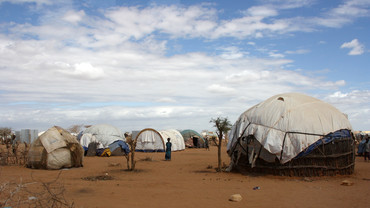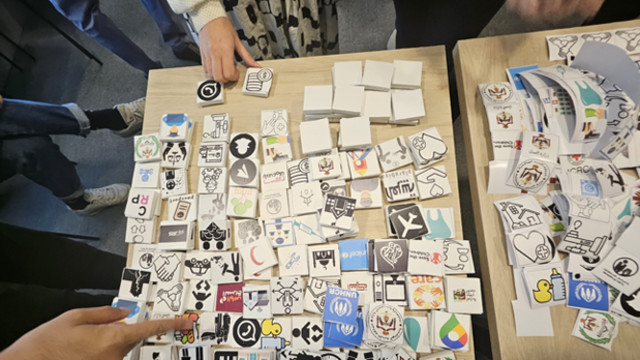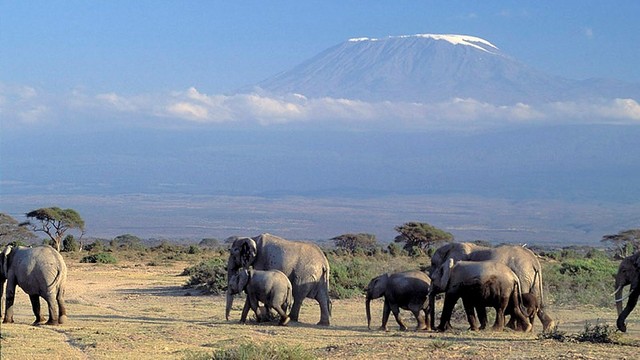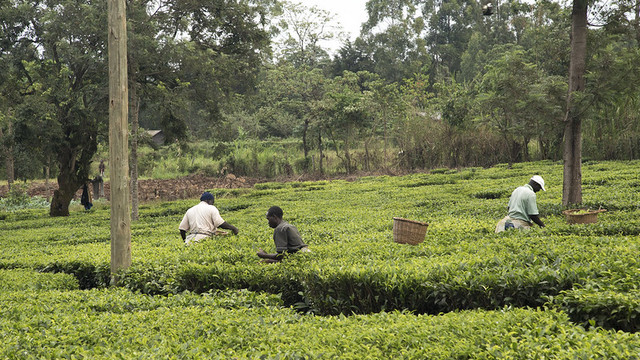Diverging paths and the route to self-reliance
Somali refugee women living in Dadaab refugee camp and Eastleigh neighbourhood in Nairobi, Kenya, share their unique experience navigating the challenges of displacement in a camp and in the city.

Street in Eastleigh, home to many Somali refugees and Kenyans of Somali origin (Photo: Arete/Brian Ongoro/IIED)
In summer 2023 IIED conducted interviews with four pairs of Somali women who are refugees living in Kenya. Having left Somalia at similar times and with similar backgrounds, four were living in Dadaab camp in the north of the country and four were living in the Eastleigh neighbourhood of the capital, Nairobi.
Life is hard for all the women, but those in Nairobi stand out for their belief that their families will eventually benefit from their struggles to earn a livelihood.
At 2am every morning, Hamdi, 25, from Mogadishu, wakes up to prepare the food she sells on the streets of Nairobi. When she’s not cooking lunch or dinner for her five children, she’s selling tea and snacks to earn money to support her family.
“Everything is money, and right now my focus is providing for my children’s basic needs. I’m a single mother handling all these bills with an unstable income,” said Hamdi.

Hamdi selling tea on the streets of Eastleigh, Nairobi (Photo: Arete/Brian Ongoro/IIED)
She came to Nairobi from Somalia with her husband and children at the age of 21. Growing up, her parents could not afford to pay her school fees, and she was married off earlier than she can remember. After giving birth to her first child when she was only 10, she is now divorced and determined to get by on her own as a refugee in Nairobi.
Even though the hours are long, Hamdi doesn’t want to live in one of Kenya’s refugee camps where she would receive food and shelter. Living costs are high in Nairobi, but Hamdi values the opportunities and the freedom to work and earn a living for herself. In the camp, she fears she would lose this.
And she’s not alone. Research conducted by IIED and partners for the 'Protracted displacement in an urban world' 'project in Kenya, Jordan and Ethiopia shows that most refugees would prefer to live in a town or city rather than a camp, despite the very limited support urban refugees receive in most countries.
Farhiyo, 39, came to Nairobi from Mogadishu in 2009 and worked as a street hawker until she recently re-married and had a baby. Like Hamdi, she worked in the streets for the sake of her children.
![Farhiyo, 39, preparing food at home. “[Street hawking] is very difficult especially with harassment from kanjos [local police] but ultimately my children don’t go hungry" A woman reaches for something from an open cupboard.](/sites/default/files/styles/scale_md/public/2023-11/Farhiyo_0.jpeg)
Farhiyo preparing food at home in Eastleigh (Photo: Arete/Brian Ongoro/IIED)
“[Street hawking] is very difficult especially with harassment from kanjos [local police] but ultimately my children don’t go hungry,” said Farhiyo.
She came to Kenya as a widow with five children, and found herself in a community of single refugee women supporting each other. They band together to form savings groups known as ayuutos or merry-go-rounds, where each member regularly makes a payment to a communal pot of money that can be used for collective investments or emergency expenses.
For working mothers like Hamdi and Farhiyo, targeted support could make a big difference – for their businesses and their families. Many refugee women like her work as street hawkers, which is a vulnerable occupation.
Those who can’t afford to pay rent or permit fees to sell their goods in a dedicated marketplace or shop must sell on streets. They may be chased away by local police or harassed by shop owners who see them as unwelcome competition. Sometimes all their goods are confiscated, and they are left without income for the day.
Still, these women don’t consider the refugee camp an option, and the reasons are many: lack of employment opportunities, the hot weather, and in some cases, the lack of healthcare. But for every woman struggling to make ends meet in Nairobi, there are many more in the camp with aspirations to leave. Their lives are very different.
Habibo, 38, came to Dadaab from a rural area in Somalia when she was 19. Living with her husband and ten children, she doesn’t have time for herself, but is focused on the education and future of her children.
She knows the many years of childbirth are taking their toll on her health, especially since the family can’t afford to buy nutritious food. Habibo keeps goats in her yard to make use of her skills as a pastoralist, but she dreams of living in a town or a city.

Habibo tending goats outside her shelter in Dadaab (Photo: Arete/Brian Ongoro/IIED)
“I look forward to a better life outside the camp, a life where I’m empowered enough to also help my old mum and siblings who still live in the countryside in Somalia,” said Habibo.
Free education is valued by many in the camp, but there are limited opportunities to put that education to use. Amal, 25, was only 12 when she came to Kenya by herself. Even as a child, she chose to leave the camp to support herself instead of going to school.

Amal at work in a clothing shop in an Eastleigh mall (Photo: copyright Arete/Brian Ongoro/IIED)
Today she works in a shop selling clothes, and dreams of starting her own business. But without assistance in the city, she was not able to also pay for her own education. Working seven days a week, she has no time for fun – or to start the family she also dreams of having. But the camp was never an option.
“[In the camp] I would not be able to work and empower myself. When UNHCR gave me the [refugee] mandate, they asked me if I was comfortable to live in Dadaab/Ifo camp and I said no,” Amal recalled. “They asked if I am able to provide for myself and I told them that I was.”
Amal, Farhiyo and Hamdi epitomise the determination of so many refugee women who make the difficult decision to live without humanitarian assistance in the city.
Many are already organised in savings groups, and could be easily reached with a range of interventions that could make a big difference to their working and family lives. For example, low-interest loans that would allow them to buy products in bulk to sell at a greater profit, affordable childcare so they can go out to work without worrying about their children’s safety, and micro-insurance to protect against theft of their goods or loss of business.
Steps by the Nairobi City County Authority to reduce harassment by the police and prevent other abuses against street hawkers would also greatly benefit their wellbeing, helping them achieve their goals of a stable income to support themselves and their families.
Photo gallery
Text by Boel McAteer; research by Hafsa Mohamud Ali.

![Faduma, 33, preparing food for her children in Dadaab. "When I first arrived [from Kismayo] I lived in a temporary structure covered with canvas. I would do odd jobs around the camp and then I started a small vegetable business. I also started baking cakes and hawking around the camp. The UNHCR gives us food, we have ration cards for collecting our food every month. I have thought of moving to a city but I cannot afford to. In a city I believe I could work in hotels as a housekeeper. I believe I could also join evening tuition classes and my children could have a better life than the one we have in the camp." Woman sitting on a stool prepares rice from a pot.](/sites/default/files/styles/square_thumbnail/public/2023-11/Faduma_0.jpeg)
![Nooriyo, 27, walks across her compound in Dadaab. "When I came to the camp I was hopeful my life would change for the better, I went to school and I started thinking of living a good life outside the camp. I have not yet received any other training or skills. I would love to partake in anything that earns me a living, like starting a small business and working in the health sector too. I used to think about what kind of life I would have in the camp and because of the presence of so many NGOs working to help people, I thought it was going to be a good life, a life different from where I fled from, where I could do business, get a quality education or be relocated within a few years. But none of that happened. It's not different from our place [Somalia]. The only difference is the peace." Woman standing on dirt ground.](/sites/default/files/styles/square_thumbnail/public/2023-11/Nooriyo_0.jpeg)
![Hakima, 42, hangs laundry outside her shelter in Dadaab. "I had hoped for a very bright future for my children and myself [in the camp]. I had big dreams when I was moving here, for my personal growth and that of my children. I also dreamt of studying but I never got the opportunity. I always wanted to study so that I would be able to help my children. I want my children to study and get the best education. I don’t want them to end up like me, illiterate and vulnerable. The main reason why I moved here was for my children’s safety and education. That is why I’m patient and resilient despite all the hardships that we are going through. I wanted to move to Nairobi but I was told if you don’t have papers you are not allowed to move to Nairobi." A woman hols a piece of clothes looking at a drying line.](/sites/default/files/styles/square_thumbnail/public/2023-11/Hakima_0.jpeg)


![Farhiyo, 39, preparing food at home. “[Street hawking] is very difficult especially with harassment from kanjos [local police] but ultimately my children don’t go hungry" A woman reaches for something from an open cupboard.](/sites/default/files/styles/square_thumbnail/public/2023-11/Farhiyo_0.jpeg)





